Investigation on Traffic Carbon Emission Factor Based on Sensitivity and Uncertainty Analysis
Abstract
1. Introduction
2. Materials and Methods
2.1. Data Source
2.2. VSP Binning Method
2.3. Active Subspace Method
2.4. Bayesian Linear Regression
3. Results and Discussion
3.1. Multivariate Sensitivity Analysis of CO2 Emission Factor
3.2. Inference of CO2 Emission Factor by Bayesian Regression
3.3. The Influence of Distribution Functions on Multivariate Analysis
4. Conclusions
Author Contributions
Funding
Data Availability Statement
Conflicts of Interest
References
- Hu, G.; Zeng, W.; Yao, R.; Xie, Y.; Liang, S. An integrated assessment system for the carrying capacity of the water environment based on system dynamics. J. Environ. Manag. 2021, 295, 113045. [Google Scholar] [CrossRef] [PubMed]
- Chen, Z.; Li, B.; Jia, S.; Ye, X. Modeling and simulation analysis of vehicle pollution and carbon reduction management model based on system dynamics. Environ. Sci. Pollut. Res. Int. 2023, 30, 14745–14759. [Google Scholar] [CrossRef] [PubMed]
- IEA. CO2 Emissions in 2023; IEA: Paris, France, 2024; Available online: https://www.iea.org/reports/co2-emissions-in-2023 (accessed on 27 April 2023).
- Li, Y.; Dong, H.; Lu, S. Research on application of a hybrid heuristic algorithm in transportation carbon emission. Environ. Sci. Pollut. Res. 2021, 28, 48610–48627. [Google Scholar] [CrossRef] [PubMed]
- Wang, L.; Zhao, Y.; Wang, J.; Liu, J. Regional inequality of total factor CO2 emission performance and its geographical detection in the China’s transportation industry. Environ. Sci. Pollut. Res. Int. 2022, 29, 3037. [Google Scholar] [CrossRef] [PubMed]
- IEA. Energy Technology Perspectives 2015; OECD Publishing: Paris, France, 2015. [Google Scholar]
- Yao, Z.; Cao, H.; Cui, Z.; Wang, Y.; Huang, N. Research on Urban Distribution Routes Considering the Impact of Vehicle Speed on Carbon Emissions. Sustainability 2022, 14, 15827. [Google Scholar] [CrossRef]
- Dong, Y.; Xu, J.; Ni, J. Carbon emission model of vehicles driving at fluctuating speed on highway. Environ. Sci. Pollut. Res. Int. 2023, 30, 18064–18077. [Google Scholar] [CrossRef] [PubMed]
- Rakha, H.; Ahn, K.; Trani, A. Development of VT-Micro model for estimating hot stabilized light duty vehicle and truck emissions. Transportation research. Part D Transp. Environ. 2004, 9, 49–74. [Google Scholar] [CrossRef]
- Kim, W.; Kim, C.; Lee, J.; Kim, J.; Yun, C.; Yook, S. Fine particle emission characteristics of a light-duty diesel vehicle according to vehicle acceleration and road grade. Transp. Res. Part D Transp. Environ. 2017, 53, 428–439. [Google Scholar] [CrossRef]
- Zhao, F.; Liu, F.; Liu, Z.; Hao, H. The correlated impacts of fuel consumption improvements and vehicle electrification on vehicle greenhouse gas emissions in China. J. Clean. Prod. 2019, 207, 702–716. [Google Scholar] [CrossRef]
- Li, X.; Yu, B. Peaking CO2 emissions for China’s urban passenger transport sector. Energy Policy 2019, 133, 110913. [Google Scholar] [CrossRef]
- Pu, X.; Lu, X.; Han, G. An improved optimization algorithm for a multi-depot vehicle routing problem considering carbon emissions. Environ. Sci. Pollut. Res. Int. 2022, 29, 54940–54955. [Google Scholar] [CrossRef] [PubMed]
- Jimenez-Palacios, J.L. Understanding and Quantifying Motor Vehicle Emissions with Vehicle Specific Power and TILDAS Remote Sensing; Massachusetts Institute of Technology: Cambridge, MA, USA, 1999. [Google Scholar]
- Song, G.; Lei, Y. Characteristics of low-speed vehicle-specific power distributions on urban restricted-access roadways in Beijing. Transp. Res. Rec. 2011, 2233, 90–98. [Google Scholar] [CrossRef]
- Forcetto, A.L.S.; de Salvo Junior, O.; Maciel Filho, F.F.; de Fátima Andrade, M.; de Almeida, F.; Flávio Guilherme, V. Improving the assessment of RDE dynamics through vehicle-specific power analysis. Environ. Sci. Pollut. Res. Int. 2022, 29, 59561–59574. [Google Scholar] [CrossRef] [PubMed]
- Zhang, L.; Zhu, Z.; Zhang, Z.; Song, G.; Zhai, Z.; Yu, L. An improved method for evaluating eco-driving behavior based-on speed-specific vehicle-specific power distributions. Transp. Res. Part D Transp. Environ. 2022, 113, 103476. [Google Scholar] [CrossRef]
- Amoatey, P.; Omidvarborna, H.; Baawain, M.S.; Al-Mamun, A. Evaluation of vehicular pollution levels using line source model for hot spots in Muscat, Oman. Environ. Sci. Pollut. Res. Int. 2020, 27, 31184–31201. [Google Scholar] [CrossRef] [PubMed]
- Smit, R.; Awadallah, M.; Bagheri, S.; Surawski, N.C. Real-world emission factors for SUVs using on-board emission testing and geo-computation. Transp. Res. Part D Transp. Environ. 2022, 107, 103286. [Google Scholar] [CrossRef]
- EPA. User’s Guide to Mobile4 (Mobile Source Emission Factor Model); Office of Mobile Sources U.S. Environmental Protection Agency Ann Arbor: Washington, DC, USA, 1989. [Google Scholar]
- EPA. User’s Guide to MOBILE6.1 and MOBILE6.2: Mobile Source Emission Factor Model [CP/OL]. 2008. Available online: http://www.epa.gov/oms/m6.htm,2008/04/05 (accessed on 27 April 2023).
- Khazini, L.; Kalajahi, M.J.; Blond, N. An analysis of emission reduction strategy for light and heavy-duty vehicles pollutions in high spatial–temporal resolution and emission. Environ. Sci. Pollut. Res. Int. 2022, 29, 23419–23435. [Google Scholar] [CrossRef]
- Charles, R.; Crawford. Active Subspaces: Emerging Ideas for Dimension Reduction in Parameter Studies; SIAM: Philadelphia, PA, USA, 2016. [Google Scholar]
- Constantine, P.G.; Emory, M.; Larsson, J.; Iaccarino, G. Exploiting active subspaces to quantify uncertainty in the numerical simulation of the HyShot II scramjet. J. Comput. Phys. 2015, 302, 1–20. [Google Scholar] [CrossRef]
- Constantine, P.G.; Diaz, P. Global sensitivity metrics from active subspaces. Reliab. Eng. Syst. Saf. 2017, 162, 1–13. [Google Scholar] [CrossRef]
- Seshadri, P.; Shahpar, S.; Constantine, P.; Parks, G.; Adams, M. Turbomachinery Active Subspace Performance Maps. J. Turbomach. 2018, 140, 041003. [Google Scholar] [CrossRef]
- Bahamonde, S.; Pini, M.; De Servi, C.; Schiffmann, J.; Colonna, P. Corrigendum to “Active subspaces for the optimal meanline design of unconventional turbomachinery” [Appl. Therm. Eng. 2017, 127, 1108–1118]. Appl. Therm. Eng. 2019, 150, 1353–1355. [Google Scholar] [CrossRef]
- Ji, W.; Ren, Z.; Marzouk, Y.; Law, C.K. Quantifying kinetic uncertainty in turbulent combustion simulations using active subspaces. Proc. Combust. Inst. 2019, 37, 2175–2182. [Google Scholar] [CrossRef]
- Zhang, L.; Wang, N.; Wei, J.; Ren, Z. Exploring active subspace for neural network prediction of oscillating combustion. Combust. Theory Model. 2021, 25, 570–587. [Google Scholar] [CrossRef]
- Lin, K.; Zhou, Z.; Wang, Y.; Law, C.K.; Yang, B. Using active subspace-based similarity analysis for design of combustion experiments. Proc. Combust. Inst. 2023, 39, 5177–5186. [Google Scholar] [CrossRef]
- Chen, D.; Dahlgren, R.A.; Shen, Y.; Lu, J. A Bayesian approach for calculating variable total maximum daily loads and uncertainty assessment. Sci. Total Environ. 2012, 430, 59–67. [Google Scholar] [CrossRef] [PubMed]
- Rajamand, S.; Caglar, R. Control of voltage and frequency based on uncertainty analysis using Bayesian method and effective power flow control of storage role in electrical vehicle charging station. Sustain. Energy Grids Netw. 2022, 32, 100837. [Google Scholar] [CrossRef]
- Elster, C.; Toman, B. Bayesian uncertainty analysis for a regression model versus application of GUM Supplement 1 to the least-squares estimate. Metrologia 2011, 48, 233–240. [Google Scholar] [CrossRef][Green Version]
- Lu, D.; Ye, M.; Hill, M.C. Analysis of regression confidence intervals and bayesian credible intervals for uncertainty quantification. Water Resour. Res. 2012, 48, W09521.1–W09521.20. [Google Scholar] [CrossRef]
- Li, X.; Feng, J.; Wellen, C.; Wang, Y. A Bayesian approach of high impaired river reaches identification and total nitrogen load estimation in a sparsely monitored basin. Environ. Sci. Pollut. Res. Int. 2017, 24, 987–996. [Google Scholar] [CrossRef]
- Mudgal, A.; Hallmark, S.; Carriquiry, A.; Gkritza, K. Driving behavior at a roundabout: A hierarchical Bayesian regression analysis. Transp. Res. Part D Transp. Environ. 2014, 26, 20–26. [Google Scholar] [CrossRef]
- Martin, N.P.D.; Bishop, J.D.K.; Choudhary, R.; Boies, A.M. Can UK passenger vehicles be designed to meet 2020 emissions targets? A novel methodology to forecast fuel consumption with uncertainty analysis. Appl. Energy 2015, 157, 929–939. [Google Scholar] [CrossRef]
- EPA. Methodology for Developing Modal Emission Rates for EPA’s Multi-Scale Motor Vehicle and Equipment Emission System; EPA: Washington, DC, USA, 2002.
- Jefferson, J.L.; Gilbert, J.M.; Constantine, P.G.; Maxwell, R.M. Active subspaces for sensitivity analysis and dimension reduction of an integrated hydrologic model. Comput. Geosci. 2015, 83, 127–138. [Google Scholar] [CrossRef]
- Yu, W.; Zhao, F.; Yang, W.; Zhu, Q. Uncertainty quantifications of calibrating laser-induced incandescence intensity on sooting propensity in a wick-fed diffusion flame burner. Fuel 2021, 289, 119921. [Google Scholar] [CrossRef]
- Kelly, B.C. Some Aspects of Measurement Error in Linear Regression of Astronomical Data. Astrophys. J. 2007, 665, 1489–1506. [Google Scholar] [CrossRef]
- Shuai, M.; Zhihui, H.; Liang, J.; Haiguang, Z.; Tian, M. CO2 and NOx emission characteristics from a heavy-duty China VI diesel truck based on portable emission measurement system. Acta Sci. Circumstantiae 2022, 42, 341–350. [Google Scholar] [CrossRef]
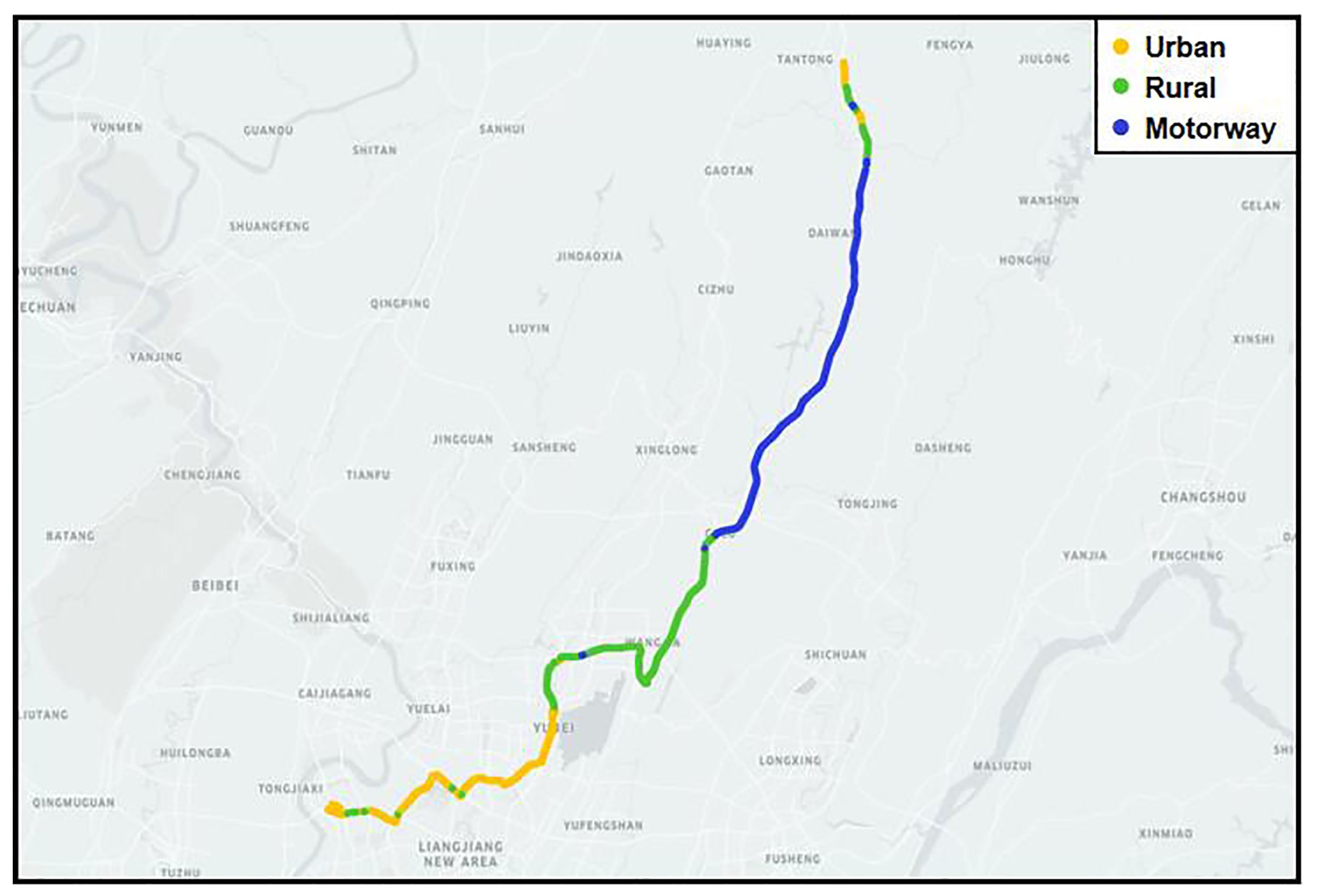
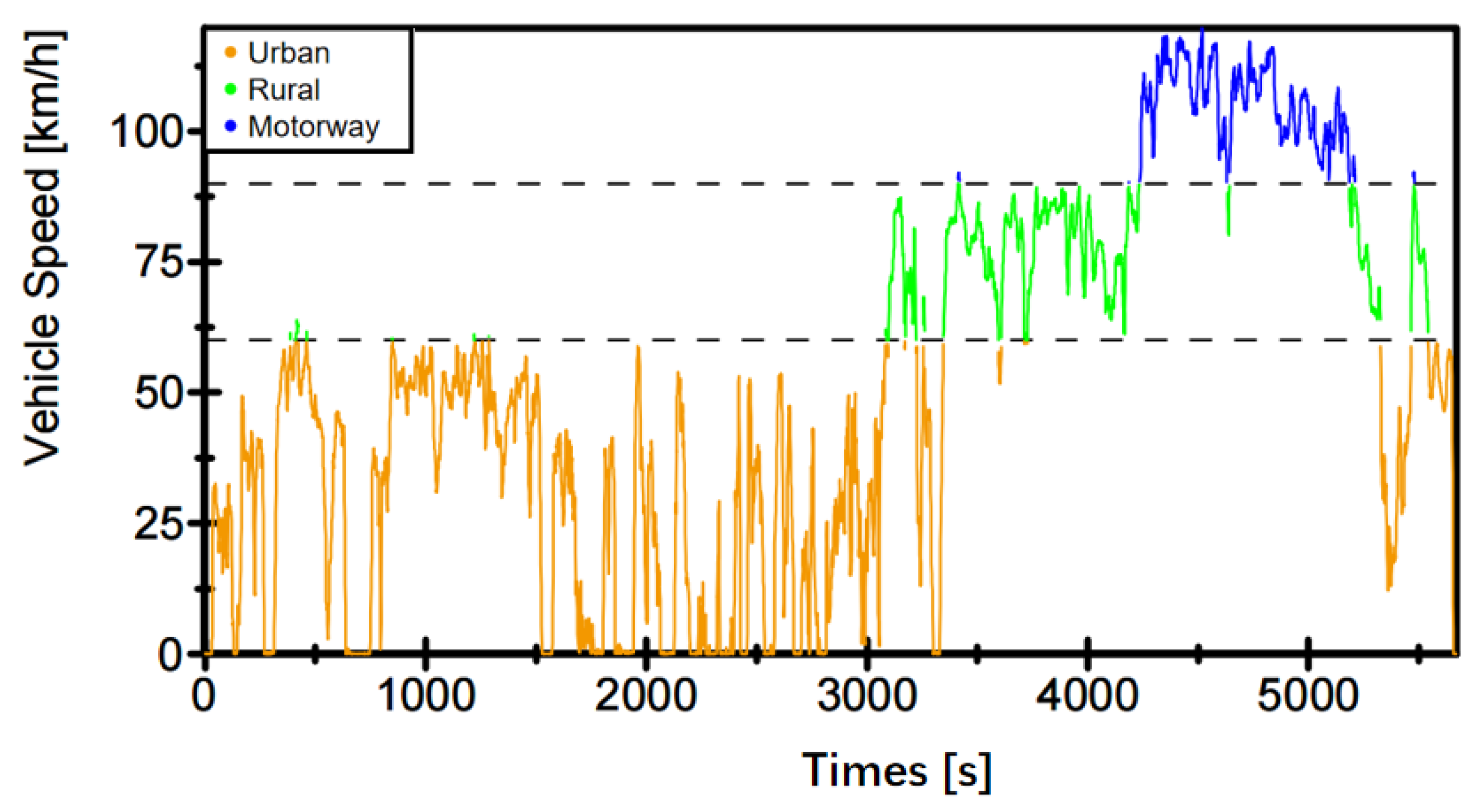

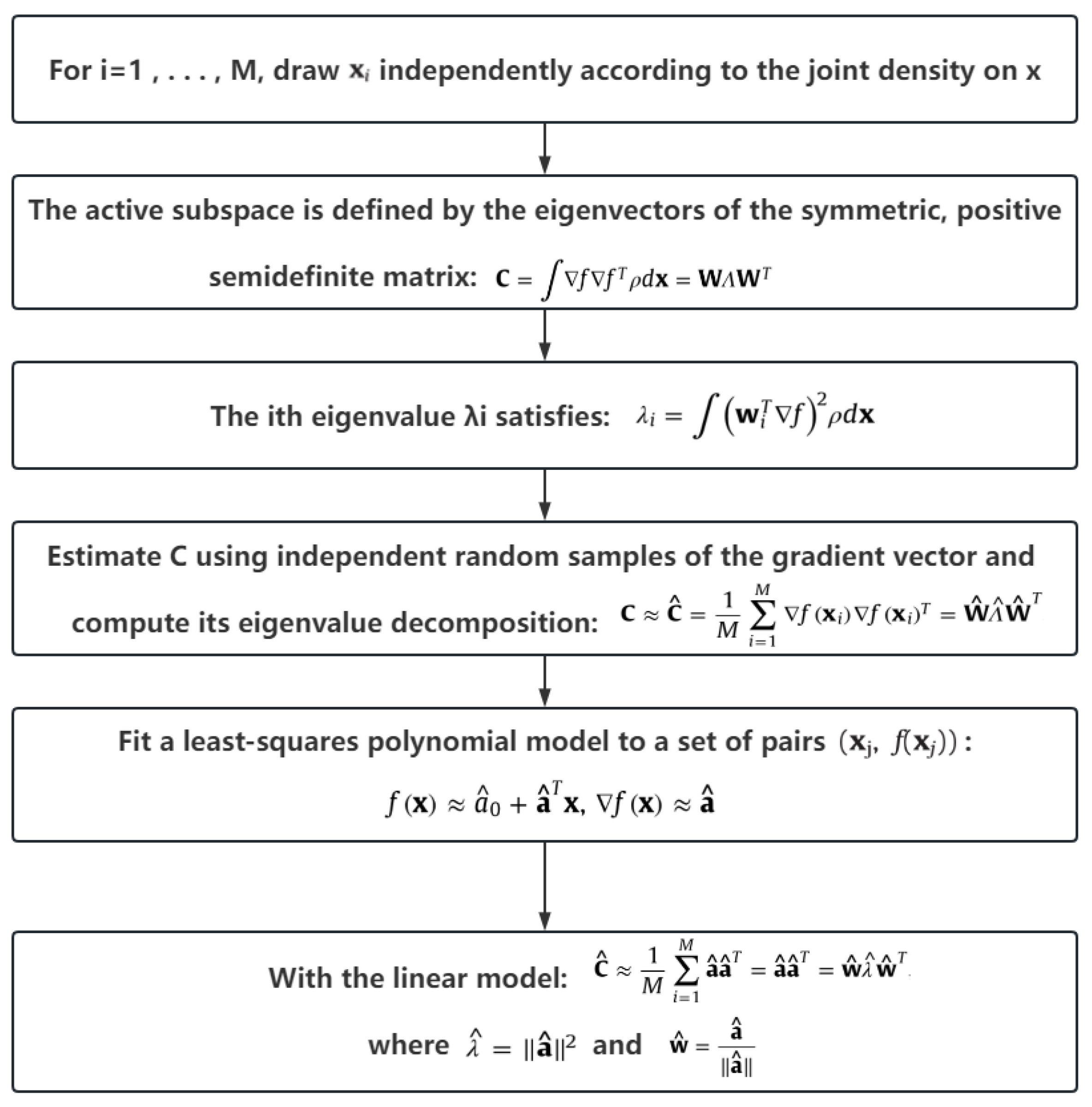
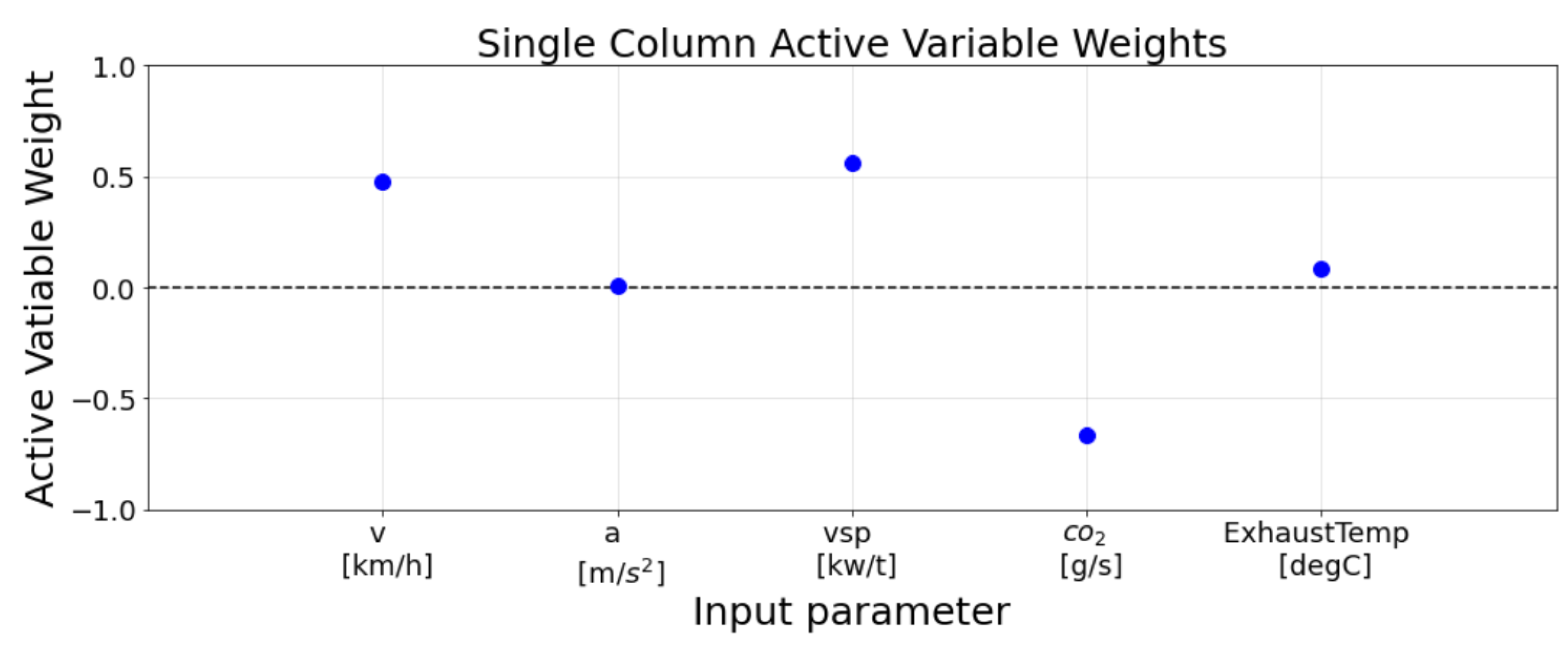
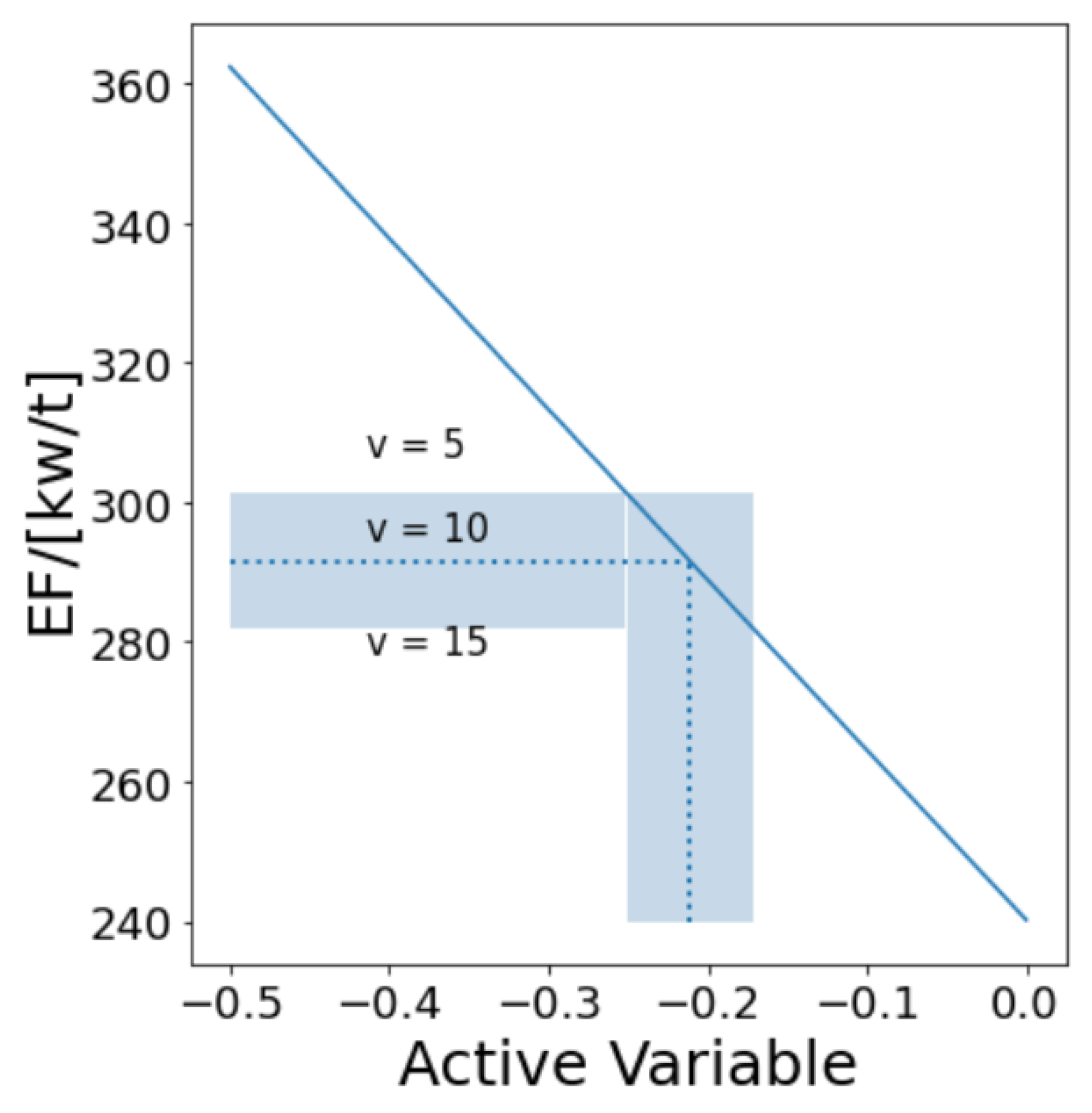


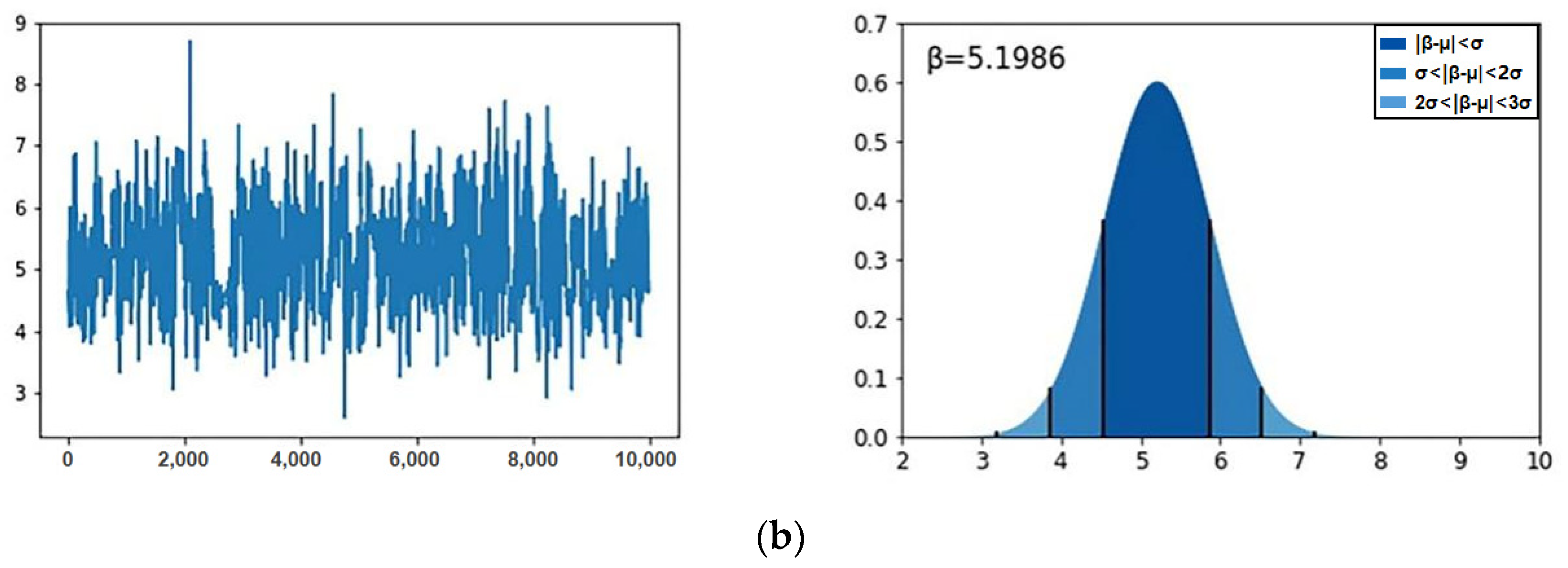
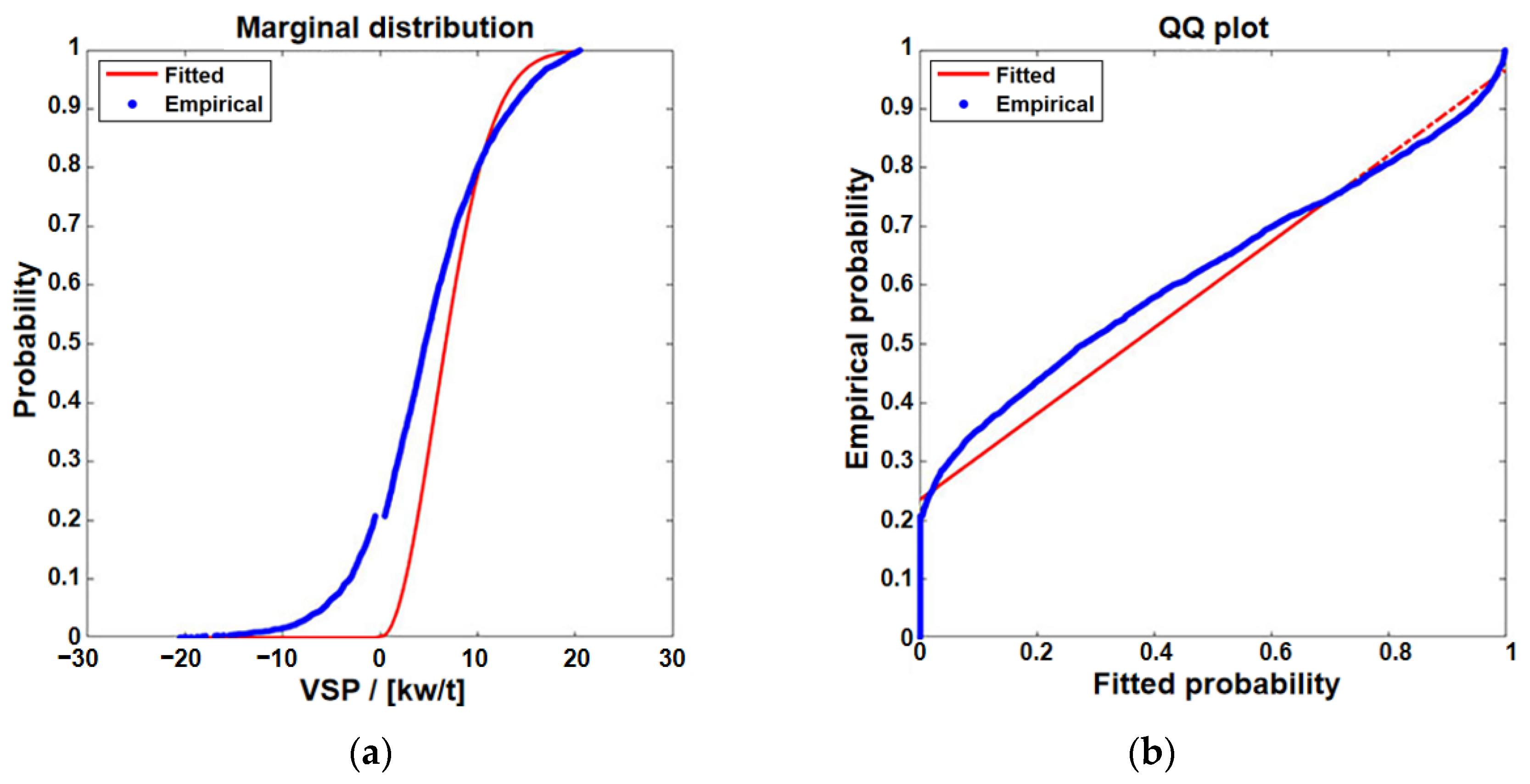
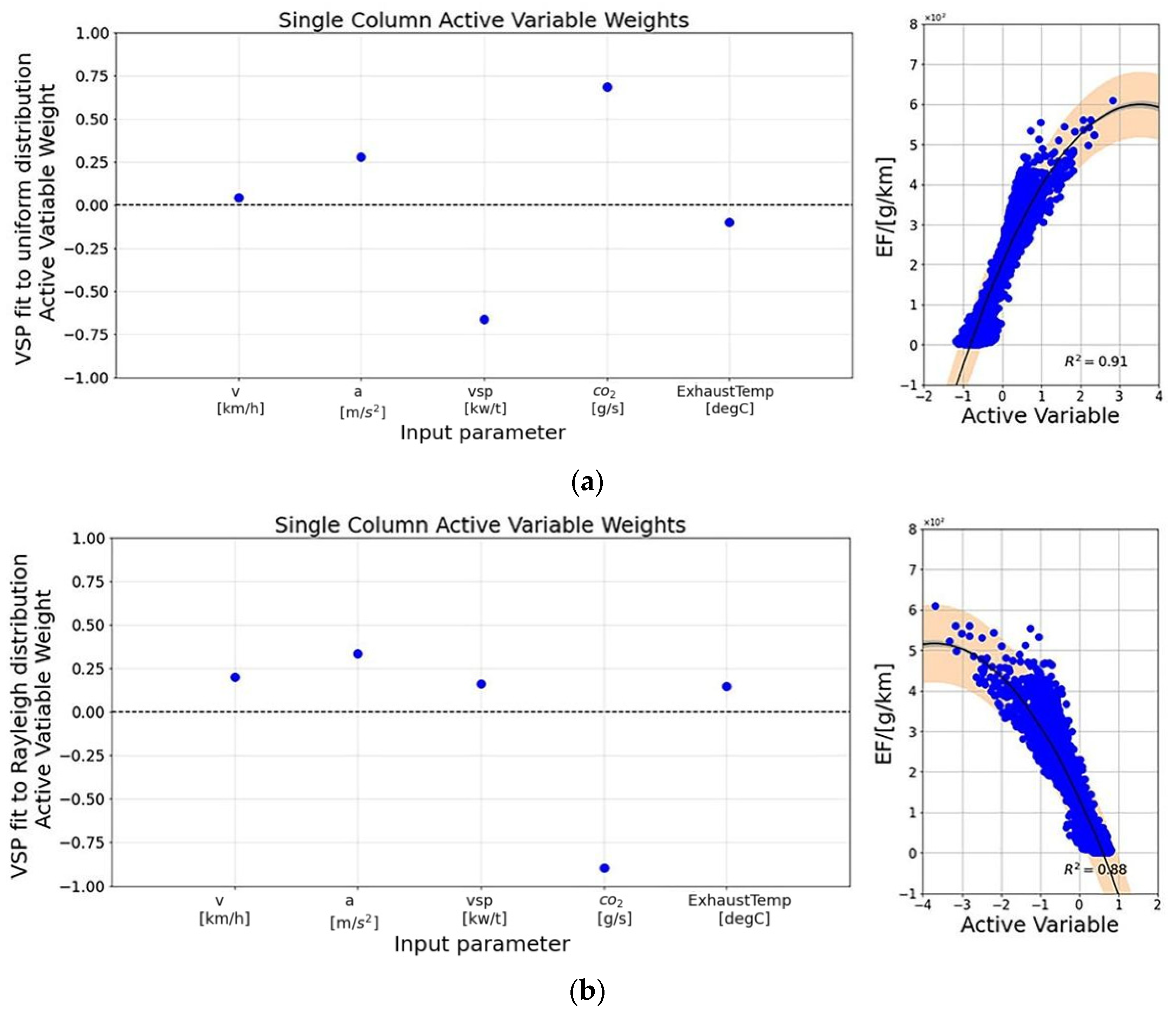
| Urban | Rural | Motorway | Total | |
|---|---|---|---|---|
| Average Speed (km/h) | 28.2 | 77.6 | 106.0 | |
| Distance (km) | 27.2 | 26.7 | 28.3 | 82.096 |
| Duration (h:min:s) | 0:57:52 | 0:20:36 | 0:16:00 | 1:34:28 |
| Distribution | C0 | C1 | C2 | R2 |
|---|---|---|---|---|
| Rayleigh | 122.59 | −124.90 | −29.29 | 0.88 |
| Uniform | 202.63 | 224.32 | −31.76 | 0.91 |
Disclaimer/Publisher’s Note: The statements, opinions and data contained in all publications are solely those of the individual author(s) and contributor(s) and not of MDPI and/or the editor(s). MDPI and/or the editor(s) disclaim responsibility for any injury to people or property resulting from any ideas, methods, instructions or products referred to in the content. |
© 2024 by the authors. Licensee MDPI, Basel, Switzerland. This article is an open access article distributed under the terms and conditions of the Creative Commons Attribution (CC BY) license (https://creativecommons.org/licenses/by/4.0/).
Share and Cite
Chen, J.; Yu, H.; Xu, H.; Lv, Q.; Zhu, Z.; Chen, H.; Zhao, F.; Yu, W. Investigation on Traffic Carbon Emission Factor Based on Sensitivity and Uncertainty Analysis. Energies 2024, 17, 1774. https://doi.org/10.3390/en17071774
Chen J, Yu H, Xu H, Lv Q, Zhu Z, Chen H, Zhao F, Yu W. Investigation on Traffic Carbon Emission Factor Based on Sensitivity and Uncertainty Analysis. Energies. 2024; 17(7):1774. https://doi.org/10.3390/en17071774
Chicago/Turabian StyleChen, Jianan, Hao Yu, Haocheng Xu, Qiang Lv, Zongqiang Zhu, Hao Chen, Feiyang Zhao, and Wenbin Yu. 2024. "Investigation on Traffic Carbon Emission Factor Based on Sensitivity and Uncertainty Analysis" Energies 17, no. 7: 1774. https://doi.org/10.3390/en17071774
APA StyleChen, J., Yu, H., Xu, H., Lv, Q., Zhu, Z., Chen, H., Zhao, F., & Yu, W. (2024). Investigation on Traffic Carbon Emission Factor Based on Sensitivity and Uncertainty Analysis. Energies, 17(7), 1774. https://doi.org/10.3390/en17071774







